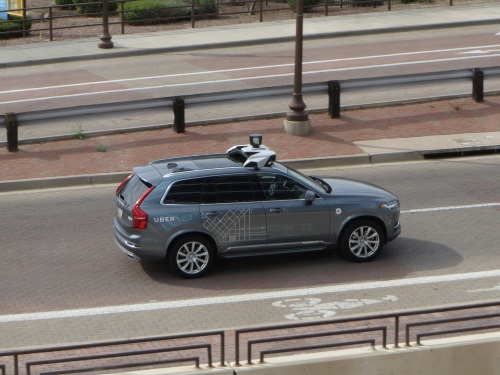The World Economic Forum launched a new collaborative effort on September 23 that seeks to reduce passenger mobility greenhouse gas GHG emissions by 95 percent worldwide via greater use of ridesharing, electric vehicles, and autonomous transportation.
[Above photo by Uber.]
The WEF’s global new mobility coalition or GNMC – made up of a group of over 100 experts, non-governmental originations (NGOs), and private companies – plans to promote what it calls shared, electric, and autonomous mobility or SEAM policies to reduce GHG emissions by 95 percent while improving mobility efficiency by 70 percent and lowering commuting costs by 40 percent.

Maya Ben Dror, the WEF’s lead for autonomous and urban mobility, noted in a statement that her organization calculates that passenger vehicles account for 70 percent of these mobility GHG emissions and cause over 50 percent of city air pollution.
“With a SEAM mobility approach, we could reduce the number of vehicles from the projected 2.1 billion to 500 million and carbon emissions from 4,600 megatons to less than 700 megatons by 2050, while also accounting for increasing mobility demand,” she explained.
“Now that new mobility solutions such as dock-less bikes and ride-hailing have abrupted commuting norms, private and public sector leaders have to rethink space and costs of mobility options,” Ben Dror said.
[Automated shuttle buses are another aspect of the SEAM mobility approach; one that state departments of transportation, such as the Utah DOT as seen in the video below, are experimenting with.]
For example, Ben Dror said that by investing in faster charging for high-occupancy shared rides in electric vehicles – as opposed to single occupancy units – not only will the electrification of fleets be encouraged but there will also be higher utilization of every vehicle on the road.
“This will lead to less street space needed to move the same amount of people at equal or higher speeds,” she pointed out. “It takes 13 lanes to move 10,000 people in cars and just two to move them in high occupancy modes.”
Accelerating the use of SEAM technologies can also free up to 90 percent of street and parking space for other uses while ensuring mobility access for all, Ben Dror added.
State departments of transportation are engaging in a similar “rethink” of mobility strategy from an infrastructure perspective.

For example, Carlos Braceras – executive director of the Utah Department of Transportation and 2018-2019 president for the American Association of State Highway and Transportation Officials – emphasized in testimony before the Senate Environment and Public Works committee in July that “there is no realm where our current inflection point in transportation history is better represented than in cooperative automated transportation, which has been defined as all modes of transportation working together to improve safety, mobility, and operations efficiency through interdependent vehicle and systems automation and information exchange.”
He explained that the merger of technology occurring today between cars, trucks and other vehicles – and with the roadway – will enable “unprecedented improvements to safety and mobility” and change the way goods, services, and people are moved via roads and highways.
However, to that end, Braceras cautioned that to successfully deploy the technology needed to manage that change, “it is more important now than ever that we respect the roles at local, state and federal levels and work hard to develop a shared vision of this transportation future in order not to be a bottleneck to continued innovation.”
 Nation
Nation


